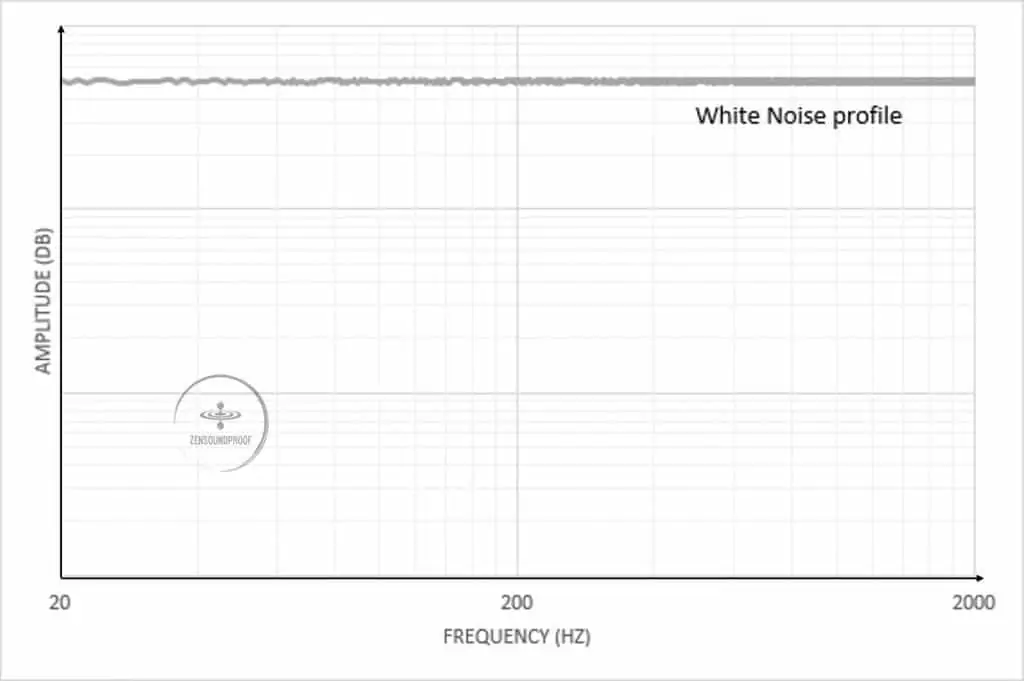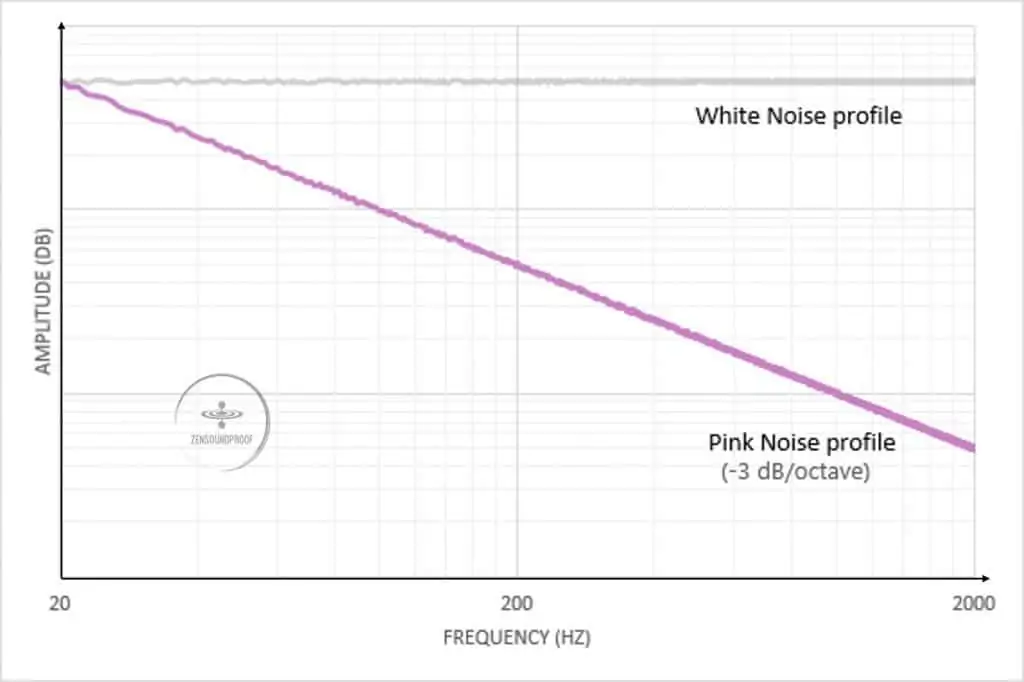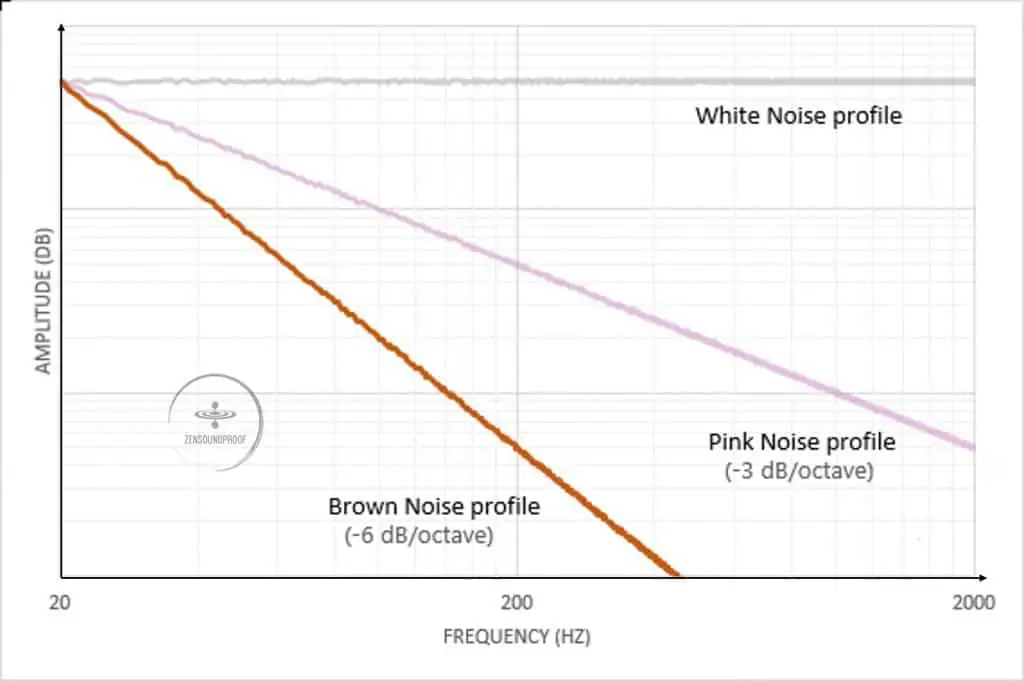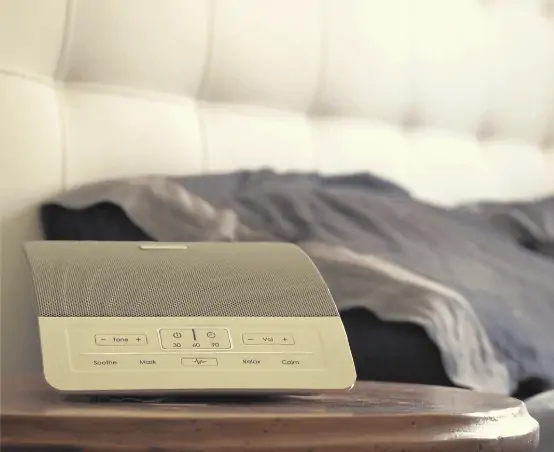Can you remember the “shhhhhhh” of an untuned TV channel? This sound is generally paired with a screen filled with black & white pixels. At this very moment, the sound emitted is white noise.
But what is white noise, exactly? What does color even have to do with noise at all? Why and how does it affect us?
To understand the concept of noise colors, turn the volume up and let your ears judge by themselves. When used correctly those colorful sounds can bring many benefits to our daily life.
Let’s tackle it.
Why Noise Colors?
Let’s start with some definitions. Noises are waves traveling through the air until they reach our eardrums. High-frequency waves let us perceive high-pitched sounds. Low-frequency waves let us perceive bass or low pitch sounds.
The human ear can perceive a broad range of frequencies. It starts at 20 Hz until 20 000 Hz and is called the human hearing range.
Similarity With Light
The term white noise comes from the nature of white light. White light is a mix of all the colors present in the visible spectrum. Similarly, white noise is a mix of sounds in the hearing range of frequency.
White Noise
To generate a white noise we need to take all the sounds over the hearing range. Each sound frequency must display the same amplitude, this is what we call white noise.
Technically speaking, white noise is a spectrum whose signal has equal power in any equal interval frequency.
It means the noise amplitude between 20 – 25 Hz, is the same as between 1000 – 1005 Hz or 1995 – 2000 Hz.
When looking at the graphic representation of white noise it has this flat representation. So to say, there’s no slope and the amplitude is constant. White noise amongst all noise colors is the most popular. It is often confused with brown or pink noise.

How does White Noise sound?
White noise can sound like an untuned radio/TV station or a whirring fan. Although it displays equal amplitude over frequency, it’s not the sound that seems the most natural to our ears. This is mainly due to our ears not sensing frequencies equally.
Pink noise
The pink noise in contrast has a decreasing slope over frequency (-3dB/octave). All high amplitude signals are focused toward low frequencies (low Hz range).
The amplitude of a pink noise signal is proportional to 1/f (“f” being the frequency in Hz).

How does Pink Noise sound?
Human ears are more sensitive to high frequencies. The pink noise helps balance this sensitivity as it has less intensity around high frequencies. Compared to white noise, it has a stronger bass rumble vibe to it, making it sound more natural. It sounds like heavy rainfalls.
Brown Noise (also called Red Noise)
The brown noise is an accentuated version of pink noise. Unlike what most people think brown color has not been named after the color brown but after “Robert Brown” (for his work about Brownian motion).
The slope for brown noise (-6dB/ octave) decreases twice more than pink noise. The amplitude of a brown noise signal is proportional to 1/f² (“f” being the frequency in Hz).

How does Brown Noise sound?
By looking at the power spectrum (figure above), we understand that most of the energy is focused on low-end frequencies. As a consequence, it has an even stronger bass accent compared to pink noise.
In nature, you can encounter brown noise when listening to strong waterfalls or ocean waves from afar.
What is a Sound Machine?
Sound machines are devices that generate a white, pink, or brown noise continuously. Also called white noise machines, their purpose is to relax the listener. It generates a background sound reminiscent of waterfall, ocean, or wind blowing that covers sources of noise disturbances.

If someday you bump into the term white noise machine, there’s a chance it’s NOT generating white noise. White noise (as explained above) can sound a little bit hissy and harsh. The machine generates instead a pink or brown noise which will seem more natural and soothing. I often use brown noise when I need to focus. It covers the sound of the air conditioner and the random sound within my house.
Nowadays, it is not necessary anymore to buy such a specific sound machine. If you want to know if it helps you focus, sleep, or any other way, there are free accessible alternatives. You can use YouTube, or APPs like “My Noise” to generate soothing background noise. I was charmed by Mynoise, you can parameter at will the color of the noise until you find your match. There is even an “ear massage” distribution that really makes me feel like rain is pouring outside. Otherwise, some appliances such as dehumidifiers and fridges emit a whirring sound which can also be used as a source of white noise.
When to use a Sound Machine?
Sound machines can be used for different purposes :
- To boost focus and productivity. It can be used at home as well as at work. There were some installed in the open office I used to work at. It did a good job to muffle conversations and coffee machine sounds. Installation-wise, it is recommended to call specific companies to do it for you. Especially if the installation has to cover a big open space. Depending on the type of noise you need to mask, you’ll have to pick a different noise color from the white, pink, and brown noise range.
Another example of use is at home when I need to focus blogging. To cover any source of distraction, I put on my earplugs and play brown noise. During the first few seconds, it always feels a bit off. But once you lay your first words on paper, you realize the environment is more conducive to work and focus. At the end of the day, I’m more than happy with the extra boost in productivity.
- To find sleep. White noise has proven virtues in finding sleep. Experiments on neonates show that when submitted to white noise, 80% would fall asleep within 5 minutes. While only 25% of the babies would fall asleep within 5min without white noise.
Another interesting study led on patients in Intensive Unit Care showed white noise could cover disturbing sounds and help them sleep more soundly. Said differently, white noise increased the peak sound intensity required to wake up patients, compared to a NON white noise environment.
- To relax. There is something calming in listening to a waterfall or hearing the roar of oceans from afar. Sound machines help to reach a relaxed state. This study from Patient Experience Journal in 2015, witnessed hospital patients agreeing on the relaxing benefits brought by sound machines.
- For sound therapy. Sound machines are used to treat some conditions such as insomnia, anxiety, and tinnitus. This is a complex topic as it’s related to specialized medical care. If you are interested in sound therapy, you can read more about it here.
Summary
I hope this piece of content made it more clear about the definition of sound colors. I didn’t bring up blue, violet, and grey noise. The reason for this is they don’t display much utility in helping us at home or at work.
Don’t hesitate to try it out. The benefits might be greater than what you might expect.
Thank you for reading,
Peace & Zen-up

1 thought on “What are Noise Colors? Improve Focus, Productivity and Sleep”
Hi, I tried the “ear massage” and I really like it.
It makes me feel calming and soothing.